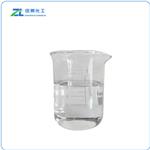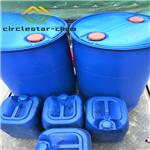Description
1-Thioglycerol is a reagent used in fluorescence, spectroscopy, and microbiology techniques. Varying the concentration of 1-thioglycerol in the preparation of CdSe/CdS core-shell ultrasmall quantum dots (CS-USQDs) allows a precise way to control the size of the shell, with shell size increasing with increased concentration. It is used as a capping agent in the synthesis of nanocrystals analyzed
via Raman and UV/Vis spectroscopy. Biologically, 1-thioglycerol stimulates porphyrin synthesis and increases glutamyl-tRNA reductase activity in
E. coli grown in an aerobic environment. It was previously a component in hair permanents used to produce waves or curls.
Chemical Properties
clear colorless to yellowish viscous solution
Chemical Properties
Monothioglycerol occurs as a colorless or pale-yellow colored,
viscous, hygroscopic liquid with a slight odor of sulfide.
Uses
It generally used as a size-regulating capping agent for nanocrystals. 1-Thioglycerol is also used in bacteriology experiments to induce the synthesis of porphyrin compounds in aerobically growing Escherichia coli. Also used to study the pH-sensitive photoluminescence of aqueous thiol-capped CdTe nanocrystals. 1-Thioglycerol is used to develop and test thiol functionalized copolymers. 1-Thioglycerol is used as a post-modification agent in the generation of non-standard peptide foldamers.Potential substitute for 2-mercaptoethanol, probe for the study of lymphocyte activation.
Uses
3-Mercapto-1,2-propanediol can be used as antioxidant preservative; reagent in analytical chemistry, cell culture research. Matrix substrate in fast atom bombardment mass spectrometry.
Uses
3-Mercapto-1,2-propanediol has been used in a study to assess the manipulation of aqueous growth of CdTe nanocrystals. It has also been used in a study that investigated the effect of surface attachment on ligand binding
Production Methods
Monothioglycerol is prepared by heating an ethanolic solution of 3-
chloro-1,2-propanediol with potassium bisulfide.
Definition
ChEBI: A thiol that is glycerol in which one of the primary hydroxy groups is replaced by a thiol group.
General Description
1-Thioglycerol stimulates the synthesis of porphyrin in aerobically growing
Escherichia coli. It is an inhibitor of glycerol kinase activity
in vitro and
in situ.
Pharmaceutical Applications
Monothioglycerol is used as an antioxidant in pharmaceutical
formulations, mainly in parenteral preparations.Monothioglycerol
is reported to have some antimicrobial activity.It is also
widely used in cosmetic formulations such as depilating agents.
Therapeutically, monothioglycerol has been used in a 0.02%
w/w aqueous solution to stimulate wound healing, and as a 0.1%
w/w jelly in atrophic rhinitis.
Safety Profile
Poison by
intraperitoneal and intravenous routes.
Experimental reproductive effects. Mutation
data reported. Flammable when exposed to
heat or flame; can react with oxidizing
materials. When heated to decomposition it
emits hghly toxic fumes of SOx.
Safety
Monothioglycerol is generally regarded as a relatively nontoxic and
nonirritant material at the concentrations used as a pharmaceutical
excipient. It is used in topical and injectable preparations.
Undiluted monothioglycerol is considered a poison by the IP and
IV routes; it has also been reported to be mutagenic.
LD
50 (cat, IV): 0.22 g/kg
LD
50 (mouse, IP): 0.34 g/kg
LD
50 (rabbit, IV): 0.25 g/kg
LD
50 (rat, IP): 0.39 g/kg
storage
Monothioglycerol is unstable in alkaline solutions. Monothioglycerol
should be stored in a well-closed container in a cool, dry place.
Incompatibilities
Monothioglycerol can react with oxidizing materials.
Regulatory Status
Included in the FDA Inactive Ingredients Database (IM, IV and
other injections). Included in the Canadian List of Acceptable Nonmedicinal
Ingredients.




